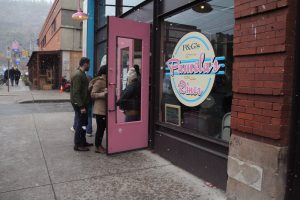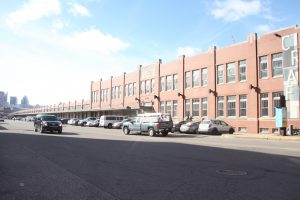Posted December 15, 2016
By MADISON BROWN
PITTSBURGH — A couple walks down the street together holding cups of coffee, snowflakes flutter to the ground, and a young woman crosses the street, her energetic golden retriever leading the way. A cluster of people huddles in the cramped entry way of Pamela’s P&G Diner, anxiously awaiting a table and some of the famous hotcakes.
The visitors have come to the Pittsburgh Strip District, an eclectic combination of shops, restaurants, clothing and food stands, international cuisine, family-owned small businesses and more located along the Allegheny River just east of the city’s downtown.
Gabriel Goldman, a resident of Polish Hill, a neighborhood bordering the Strip District, said the Strip is “one of the only places to go to for a really dense, multicultural shopping experience.”
“It’s one of the primary tourist attractions in the city,” Mark Belko, a Pittsburgh Post-Gazette real estate reporter, said.
People come to the Strip District for a variety of reasons and they have been coming for more than a century. With this long history, many changes have occurred in the Strip over the years.
Plans to redevelop the long-standing produce terminal are the latest changes the Strip District is facing. The Pennsylvania Railroad used to service the produce terminal. The 1,533 feet-long building opened in 1929 as a marketplace for vendors to sell fresh produce. Now, very few vendors sell anything in the produce terminal, but Chicago developer Dan McCaffery, CEO of McCaffery Interests, wants to change that.

People file into Pamela’s P&G Diner to put their names in for a table. On a busy day at Pamela’s, guests may wait for more than one hour before a table becomes available (Photo by Madison Brown).
“The Produce Terminal redevelopment plans propose a mix of residential, retail and office with supportive parking on the riverside,” said Pam Austin, project manager for McCaffery Interests for the redevelopment of the produce terminal.
The proposal also includes plans to make the produce terminal and the area around it more accessible for people.
“We want to put in sidewalks and streets and pedestrian access so, hopefully, the terminal will be better used than it ever has been,” said Tim McNulty, spokesperson for Pittsburgh mayor William Peduto.
Austin said that the plan is to create three pedestrian passages at 17th, 18th and 20th streets “to restore connectivity.”

The Produce Terminal opened in 1929 for people to sell fruits and vegetables wholesale. Now, the historic building will face redevelopment with retail businesses, offices and apartment buildings (Photo by Madison Brown).
The redevelopment is estimated to cost $66 million. The project is a public-private partnership with proposed funds coming from private equity and debt, grants, historic tax credits, and other sources, but total funding has not yet been determined.
The drastic change to the historic community raises questions of how it will affect the Strip District’s character.
“I think it’s really important to do no harm to the heart of the Strip District,” said Pittsburgh city councilwoman Deborah Gross.
The Strip District’s heart is made up of the businesses and people who thrive there.
Toni Haggerty, manager of Primanti Brothers, a native Pittsburgh chain restaurant that originated in the Strip District, has high expectations for the redevelopment of the produce terminal.
“Real big things are coming,” said Haggerty. “I think it’s going to be good for the business and bring in more people from out of town. It’s going to be beautiful,” she said.
Walter McCaune, assistant manager of The Pittsburgh Popcorn Company, agrees that the redevelopment could generate more foot traffic, but still has some concerns.
“I feel like obviously it’s going to bring people with income into the city and a lot more customers,” McCaune said, “but, at the same time, it’s also going to detract from what the Strip is, which is small, family-owned businesses. It might turn into something different.”

Toni Haggerty is the manager of Primanti Brothers in the Strip District. Haggerty is originally from Italy and has been working for Primanti Brothers for 42 years (Photo by Madison Brown).
John Bubin, manager of Pamela’s P&G Diner, has similar thoughts, but does not think the redevelopment will have a negative effect, just a different one. “Most businesses are small and privately owned, so more retail will definitely change the character,” Bubin said.
Goldman thinks Pittsburgh is unique because of the “gritty feel” the city has to it. The introduction of more retail stores that will come with the redevelopment could affect that.
“As long as they don’t try to make it super commercial and as long as they preserve some history, I think it will go well,” Goldman said.
The redevelopment proposal has a lot of eyes on it to make sure the Pittsburgh Strip District keeps its historic attributes and charm. For instance, an earlier plan to demolish part of the produce terminal was voted down.
Councilwoman Gross said she is pushing for a “$2 million revolving loan fund to preserve the history.”
While the final contract for redevelopment with McCaffery Interests is not yet finalized, “plans are still underway,” McNulty said.
It will take some time before people see the effects of the redevelopment.
“The project is slated to be open starting in 2018,” Austin said.
Redevelopment of the produce terminal will change the historic Strip District in many aspects.
“I think the Strip is changing for the better,” McNulty said, “but we want to make sure it doesn’t lose its character.”
